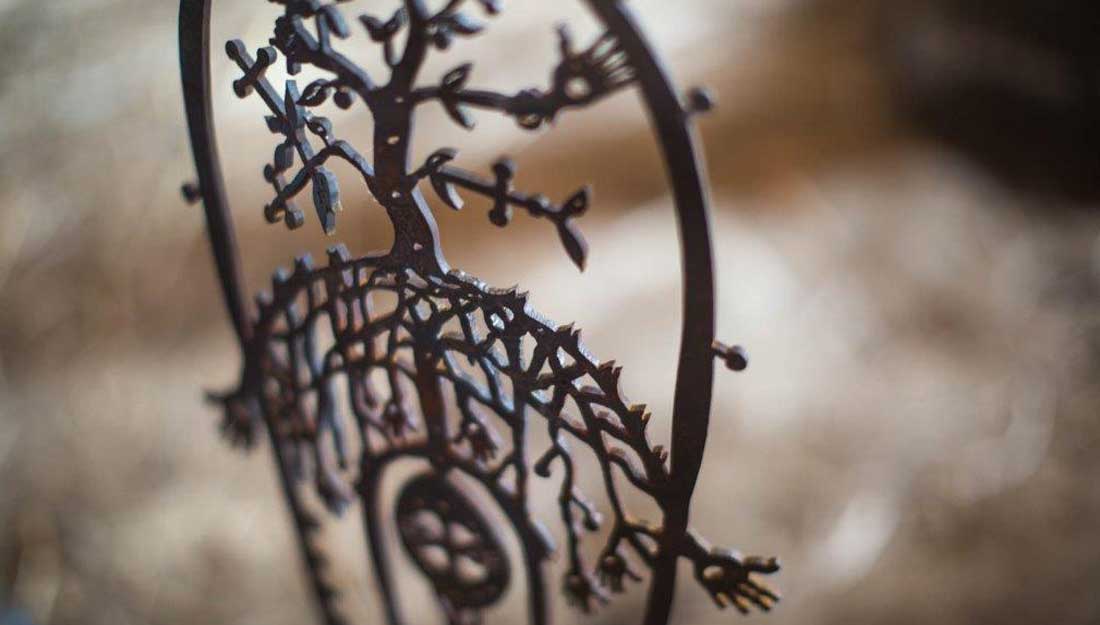A craft commissioning project initiated by Somerset Art Works in partnership with The National Trust and curated by Craftspace.

Stigmata Forks by Helen Snell (Photo:Nisha Haq)
Exhibition / Consultancy
Somerset
2015 – 2017
Gathering was a craft commissioning project initiated by Somerset Art Works in partnership with The National Trust and curated by Craftspace.
Aims
The project originated in 2015 with an aim to investigate innovative and imaginative uses of Somerset’s great tithe barns. It took place at Stoke Sub-Hamdon Priory in South Somerset, a Grade 1 listed National Trust property with a large tithe barn. The title ‘Gather-ing’ references the function of a barn as a space to collect/bring/gather people, animals and crops, as well as a symbolic meeting place to gather for celebration.
Artists
Four artists were commissioned to respond to Stoke-sub-Hamdon Priory site. Stewart Easton, musician Michael Tanner and sonic artist Gawain Hewitt. Jacky Oliver, Helen Snell, Gillian Widden and poetry technologist Christopher Jelley were associate artists. Their creative responses make particular reference to the agricultural and religious use and history of the site. Visits to Somerset Archives, contact with local historians and interactions between artists helped to inform the work. The range of ideas, skills and materials exemplify making and thinking through contemporary craft.
Stewart Easton: Interactive Quilt
Stewart Easton created an interactive quilt which depicts stories from the life of St Nicholas. Working with a local group, the Quirky Quilters, Stewart created a quilt which responds to touch by playing sounds based on the life of St Nicholas with field recordings from the local area. The fabric is digitally printed and hand stitched by Stewart using conductive thread. The edge panels have been quilted by members of the local group. In the centre, episodes from St Nicholas’s life are depicted, including the story which led to the tradition of hanging stockings at Christmas.
“The quilt will hang vertically, almost like an altar piece. A main composition will be playing continuously, while others will be triggered when someone touches different parts of the quilt. I’ve been working with a composer and a sonic artist to create the sounds, some melancholy and others joyful.” Stewart Easton
Helen Snell: Pitchfork Sculptures
Helen Snell created a series of embellished pitchfork sculptures which were raised up on mounds of earth. Helen was inspired by the use of tithes as an early form of taxation when one tenth of produce was given to the Church. Helen laser cut filigree patterns into the sculptures and worked with a blacksmith to fix the metal around ash-wood handles. One larger pitchfork sculpture was upturned, rather like a candelabrum in front of nine smaller pitchforks which dig down into the earth.
“I’ve been exploring the connections of this fascinating space to the nearby church and the tithes. The nine pitchfork sculptures are almost like a congregation with the larger pitchfork appearing as an authoritative presence. The organic laser cut patterns will let the light shine through them.” Helen Snell
Gillian Widden: Bushel Baskets
Somerset based artist Gillian Widden created a number of artworks inspired by the barn, including a series of bushel baskets in a range of sizes from one bushel down to a hundredth of a bushel. The baskets were made using grass from a nearby field which she coiled and stitched.
Gillian was inspired by the idea of bushel baskets as a container, as a measure (1 bushel is equivalent to 8 gallons), and in the phrase ‘hiding your light under a bushel’ from the parable.
“The bushel basket was introduced following the Norman Conquest and would have been used in the early life of the tithe barn as a measurement for dry goods such as grain or peas. I also feel that the saying ‘hiding your light under a bushel’ reflects my life as an artist – you have to promote yourself, and that’s not always easy.” Gillian Widden
Jacky Oliver
Jacky Oliver used metal to create small sculptures of tools that agricultural workers would traditionally have used for harvest. A winnowing basket, a flail and a breast plough were decorated with layers of images from parish records, newspapers, maps and documents, etched and cut through the surface so that light and shadow was cast on the ground.
“At the Somerset Archives the tools were brought to life by demonstrations and the opportunity to handle them. I wanted to suggest the rich history of who and where these tools would have been used.” Jacky Oliver
Working with…
Gather-ing was a Somerset Art Works project in partnership with the National Trust and curated by Craftspace.





